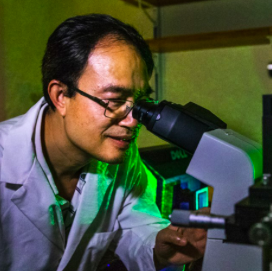

Research Terms
Keywords
Industries
The invention relates to the use of extracellular vesicles (EVs) loaded with CD24, a biological immunomodulator, for treating hypercytokinemia (also named cytokine storm, cytokine storm syndrome, or cytokine release syndrome). Hypercytokinemia can be caused by a number of infectious and non-infectious etiologies, especially viral respiratory infections such as H5N1 influenza, SARS-CoV-1, and SARS-CoV-2 (COVID-19 agent). Other causative agents include the Epstein-Barr virus, cytomegalovirus, and group A streptococcus, and non-infectious conditions such as graft-versus-host disease. The present disclosure relates to the application of EVs that are derived from any cells including human mesenchymal stem cells and are loaded with natural or engineered CD24 for therapeutic usages in human and animals.
Our invention allows one to load natural or engineered human or animal CD24 molecules into extracellular vesicles including exosomes without being cleaved or modified by extracellular enzymes, bound by host proteins, or neutralized by host immune responses. Prior to our invention, the N-terminal 56 amino acid residues of human CD24 has to been fused with the Fc region of human IgG1 (CD24Fc) before being used as a protein drug to treat hypercytokinemia.
The invention will allow a very high number of CD24 molecules to be loaded into extracellular vesicles, known as natural nanoparticles. The EVs loaded with CD24 can be directly used as therapeutic agents for treating hypercytokinemia or used in combination with other immuno modulators in order to achieve potential synergy.
Lipid vesicles (LVs) are vesicles that are enclosed by at least one lipid layer. The present invention relates to the utilization of LVs for delivery of loaded cargo molecules into cells. Any LVs may be utilized, such as liposomes, lipid nanoparticles, lipid droplets, micelles, reverse micelles, and lipid-polymer hybrid nanoparticles.
The invention facilitates the loading of diverse cargo molecules such as drugs, small molecules, nucleic acids, macromolecules, enzymes, proteins, and peptides into LVs. The cargo is then delivered into eukaryotic cells via the loaded LVs without being degraded or modified by extracellular enzymes or neutralized by host immune responses. Moreover, this protection conferred by LV-mediated delivery can be achieved without the need for chemical modification of the cargo molecule as a countermeasure, though chemical modification remains an option. Upon contacting a cell, the LV is internalized by the cell and the cargo is delivered into the cell. The cargo molecule may belong to any class of substance or combination of classes.
Extracellular vesicles (EVs) are membrane-enclosed vesicles released by cells into the extracellular space (“EV” is a collective term encompassing various subtypes of cell-released membranous structures called exosomes, microvesicles, microparticles, ectosomes, oncosomes, apoptotic bodies, and many other names in the literature). The present invention relates to the utilization of EVs for delivery of cargo molecules into cells. The present invention uses unique methods for the loading and delivery of cargo molecules into cells in vitro or in vivo, e.g., for medical, diagnostic, and biological applications.
The invention allows for the easy and efficient loading of diverse cargo molecules such as drugs, small molecules, nucleic acids, macromolecules, lipids, enzymes, proteins, and peptides into EVs. The cargo is then delivered into eukaryotic cells via the loaded EVs without being degraded or modified by extracellular enzymes or neutralized by host immune responses. Moreover, this protection conferred by EV-mediated delivery can be achieved without the need for chemical modification of the cargo molecule as a countermeasure, though chemical modification remains an option. Upon contacting a cell, the EV is internalized by the cell and the cargo is delivered into the cell.
























